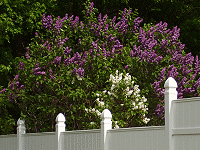Lilac plantings increase in height and size, therefore consider the impact on traffic so the planting does not become a hazard.
 The best site for a lilac is an open area with good soil drainage. Full sun is best for maximum bloom. Shade part of the day will not materially reduce flowering but the amount of bloom will lessen as the amount of shade increases. Good drainage is needed since lilacs do not like "wet feet" and will not grow well in poorly drained soil. In areas that are very wet a Berm can be constructed and the lilacs planted within the Berm. Lilacs will stand a fair amount of drought although newly set plants will need water during the first year for successful establishment.
The best site for a lilac is an open area with good soil drainage. Full sun is best for maximum bloom. Shade part of the day will not materially reduce flowering but the amount of bloom will lessen as the amount of shade increases. Good drainage is needed since lilacs do not like "wet feet" and will not grow well in poorly drained soil. In areas that are very wet a Berm can be constructed and the lilacs planted within the Berm. Lilacs will stand a fair amount of drought although newly set plants will need water during the first year for successful establishment.
Mass planting is recommended for all public areas for best landscape effect and reduction of maintenance injury. A bed of lilacs with only a one to one and a half foot of open space between the foliage masses 5’ planting on center will fill in quickly, crowding out any weeds and preventing injury from mowers, plows, or other equipment. If wider spacing is necessary, filler shrubs, to be removed later, can be added so long as there is a plan calling for their eventual removal. Safer plans include filling the initial space with annual flowers, cover it with textured mulch, such as bark, or use of a ground cover such as myrtle (Vinca minor) or pachysandra (Pachysandra terminalis).
Once established, lilacs will survive in a wide range of soils but newly set plants need a well-drained soil with pH between 6 and 7 or they will be very slow getting started. If the soil is less than ideal, organic matter will improve both drainage and moisture retention. If organic fertilizer is desired, bone meal works well although it must be applied ahead of the planting and worked into the soil because the nutrients are released very slowly.
The Landscape Division of the New Hampshire Department of Transportation prescribes the following mixture in their landscape planting specifications:
When the existing soil is to be replaced the following shall be added and thoroughly mixed with each cubic yard of loam backfill: (Note 1 cu. ft. is approximately four-fifths of a bushel) 4 cubic feet of peat moss; 10 pounds of 10-6-4 fertilizer minimum 35 percent water insoluble nitrogen (W.I.N.); and 15 pounds of ground agricultural limestone.
The NH Department of Transportation mixture varies somewhat in fertilizer recommendation but has been a very successful mixture in sites where existing soil conditions were poor. The existing soil was removed and the above loam backfill mixture added. Where soil conditions are acceptable, a soil test should be taken to determine what nutrients are needed.
next: Species and Varieties...
